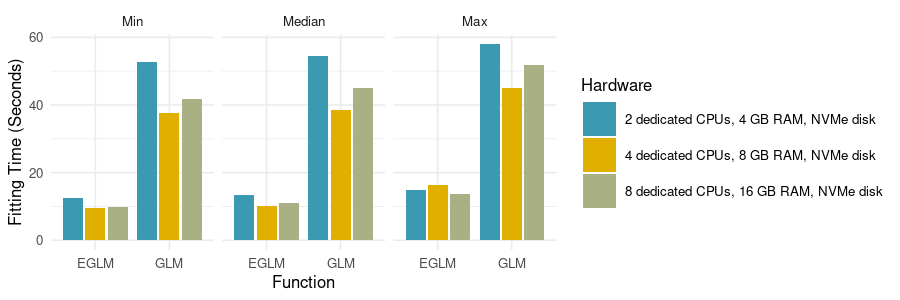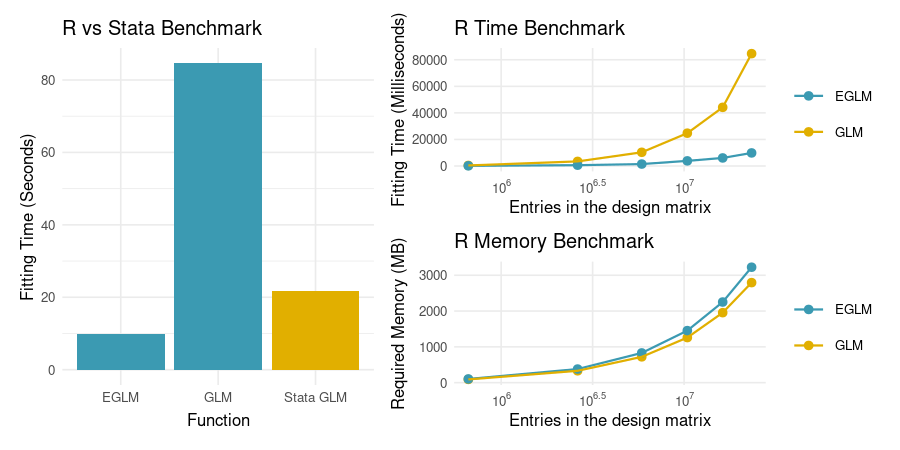See pacha.dev/capybara for a much better GLM implementation.
eflm package reduces the design matrix from N × P into P × P
for reduced fitting time, and delivers functions that are drop-in
replacements for glm and lm, like:
# just append and 'e' to glm
eglm(mpg ~ wt, data = mtcars)The best computational performance is obtained when R is linked against OpenBLAS, Intel MKL or other optimized BLAS library. This implementation aims at being compatible with ‘broom’ and ‘sandwich’ packages for summary statistics and clustering by providing S3 methods.
This package takes ideas from glm2, speedglm, fastglm, speedglm and fixest packages, but the implementations here shall keep the functions and outputs as closely as possible to the stats package, therefore making the functions provided here compatible with packages such as sandwich for robust estimation, even if that means to attenuate the speed gains.
The greatest strength of this package is testing. With more than 1600 (and counting) tests, we try to do exactly the same as lm/glm, even in edge cases, but faster.
The ultimate aim of the project is to produce a package that:
- Does exactly the same as lm and glm in less time
- Is equally numerically stable as lm and glm
- Depends only on base R, with no Rcpp or other calls
- Uses R’s internal C code such as the
Cdqrlsfunction that the stats package uses for model fitting - Can be used in Shiny dashboard and contexts where you need fast model fitting
- Is useful for memory consuming models
- Allows model fitting in cases demanding more memory than free RAM (PENDING)
You can install the released version of eflm from CRAN with:
install.packages("eflm")And the development version with:
remotes::install_github("pachadotdev/eflm")- cooks.distance
- estfun
- bread
- vcovCL
- meatCL
- vcovCL
- vcovBS
- vcovHC
- meatHC
- vcovPC
- meatPC
- vcovPL
- meatPL
- augment
- tidy
- glance
- resettest
The dataset for this benchmark was taken from Yotov et al. (2016) and consists in a 28,152 x 8 data frame with 6 numeric and 2 categorical columns of the form:
| Year (t) | Trade (X) | DIST | CNTG | LANG | CLNY | Exp Year (π) | Imp Year (χ) |
|---|---|---|---|---|---|---|---|
| 1986 | 27.8 | 12045 | 0 | 0 | 0 | ARG1986 | AUS1986 |
| 1986 | 3.56 | 11751 | 0 | 0 | 0 | ARG1986 | AUT1986 |
| 1986 | 96.1 | 11305 | 0 | 0 | 0 | ARG1986 | BEL1986 |
This data can be found in the tradepolicy package.
The variables are:
year: time of export/import flowtrade: bilateral tradelog_dist: log of distancecntg: contiguity (0/1)lang: common language (0/1)clny: colonial relation (0/1)exp_year/imp_year: exporter/importer time fixed effects
For benchmarking I’ll fit a PPML model, as it’s a computationally expensive model.
ch1_application1 <- tradepolicy::agtpa_applications %>%
select(exporter, importer, pair_id, year, trade, dist, cntg, lang, clny) %>%
filter(year %in% seq(1986, 2006, 4))
formula <- trade ~ log(dist) + cntg + lang + clny + exp_year + imp_year
eglm(formula, quasipoisson, ch1_application1)To compare glm, the proposed eglm and Stata’s ppml, I conducted a
test with 500 repetitions locally, and reported the median of the
realizations as the fitting time. The plots on the right report the
fitting times and used memory by running regressions with cumulative
subset of the data for 1986, …, 2006 (e.g. regress for 1986, then 1986
and 1990, …, then 1986 to 2006), we obtain the next fitting times and
memory allocation depending on the design matrix dimensions:
Yotov et al. (2016) features complex both partial and general equilibrium models. Some partial equilibrium models are particularly slow to fit because of the allocated memory and the number of fixed effects, such as the Regional Trade Agreements (RTAs) model.
In the next table, TG means ‘Traditional Gravity’ (e.g. vanilla PPML), DP means ‘Distance Puzzle’ and GB stands for ‘Globalization’, which are refinements of the simple PPML model and include dummy variables such as specific country pair fixed effects and lagged RTAs.
| Model | Rows in design matrix | Cols in design matrix |
|---|---|---|
| TG, PPML | 28152 | 831 |
| DP, FE | 28566 | 905 |
| RTAs, GB | 28482 | 3175 |
The results for the RTA model show that the speedups can be scaled, and we can show both time reduction and required memory increases.
| Model | GLM Time (s) | EGLM Time (s) | Time Gain (%) |
|---|---|---|---|
| DP, FE | 111.0 | 9.08 | 91.82% |
| RTAs, GB | 1824.0 | 161.40 | 91.15% |
| TG, PPML | 108.6 | 9.06 | 91.66% |
Is it important to mention that the increase in memory results in reduced object size for the stored model.
| Model | GLM Size (MB) | EGLM Size (MB) | Memory Savings (%) |
|---|---|---|---|
| DP, FE | 231.04 | 37.26 | 83.87% |
| RTAs, GB | 824.89 | 263.36 | 68.07% |
| TG, PPML | 210.88 | 34.69 | 83.55% |
To conclude my benchmarks, I fitted the PPML model again on DigitalOcean
droplets, leading to consistent times across scaled hardware. The
results can be seen in the next plot:

An elementary example that breaks eflm even with QR decomposition can
be found in Golub et al. (2013), which consists in passing an ill
conditioned matrix:
| Model | (Intercept) | x1 | x2 |
|---|---|---|---|
| REG 1 | 1.98 | 2.98 | 1.02 |
| REG 2 | 1.98 | 4.00 | NA |
Golub, Gene H, and Charles F Van Loan. 2013. Matrix Computations. Vol. 3. JHU press.
Yotov, Yoto V, Roberta Piermartini, José-Antonio Monteiro, and Mario Larch. 2016. An Advanced Guide to Trade Policy Analysis: The Structural Gravity Model. World Trade Organization Geneva.


